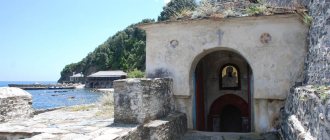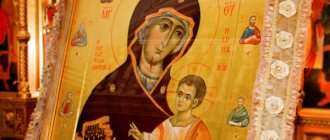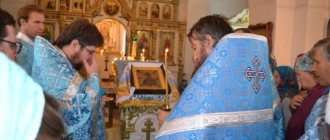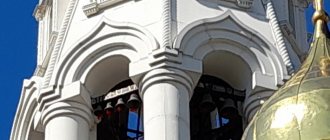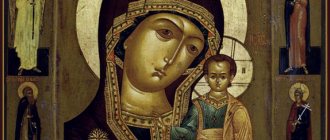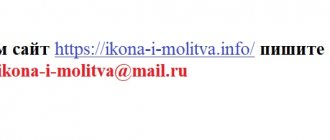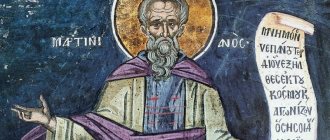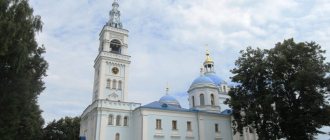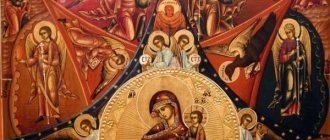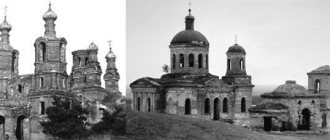Memorial Day of the Iveron Icon of the Mother of God February 25, history, features
The Iveron icon is sometimes called the Goalkeeper or the Gatekeeper. On the icon you can see the face of the Virgin Mary with little Jesus Christ in her arms. This icon is considered miraculous, therefore it is revered in many Orthodox countries, including Russia. It is surprising that the original of the holy face has survived to this day and is kept in Greece in the Iveron Temple. Historians and Orthodox leaders believe that the Apostle Luke himself wrote it.
The icon suffered its darkest times at the end of the 4th century, when there were times of iconoclasm. At that time, images of revered saints and the Lord were prohibited. The story goes that one woman decided to save the icon from her ill-wishers by lowering it into the sea. After 200 years, the icon was discovered by the monks of the Iveron Temple. According to legend, the icon was supported by a pillar of fire while underwater. The monks decided to bring the icon to the temple, but the next morning it ended up above the gate. This was repeated several times, after which the monks decided to leave it at the entrance. It is because of this that they began to call her the Goalkeeper and the Gatekeeper. In the modern world, the icon is still kept in that same monastery, but they decided to build a separate temple for it.
Tradition
This sacred icon first became known in the 9th century. The icon appeared during the reign of the Greek Emperor Theophilus. At this time, people who venerated the icons were subjected to severe torture, while the icons themselves were burned. According to legends, at that time, not far from the city of Nika, there lived a widow who had a son; this woman kept the most ancient icon of the Virgin Mary. One fine night, iconoclasts came to the woman’s home, one of them struck the sacred face with a sword. The sword hit the Virgin Mary right in the face, and blood came out of the icon.
The widow was frightened, believing that the icon could be destroyed, so she promised the imperial soldiers to pay the money and asked them to wait until the morning and not touch the sacred face. The iconoclasts agreed, because everyone needs money. When the iconoclasts left, the widow and her son lowered it into the sea to preserve the Holy Icon. The widow was very surprised when the icon did not fall, but stood upright, facing the shore. Sliding through the waters, the sacred face began to move away until it disappeared from view.
No one knows what happened next to this widow, but her son safely reached Athos, where he became a monk of the Iveron Temple. From him the monks of the Holy Mountain learned about the history of the sacred face. The bleeding wound remained on the face of the Virgin Mary, which is why the Iveron Mother of God is always depicted with a small wound on her face.
Finding
Several centuries later, the monks of the Iveron Temple on Mount Athos saw an icon in the depths of the sea, which was surrounded by a pillar of fire. After a prayer service for the donation of the shrine that had appeared to the temple, the pious monk of the Iveron Church, Saint Gabriel the Gruzin, obeying the Mother of God, who appeared to him in a dream, walked on the water and took on the sacred face, after which he placed it in the temple.
The next day, the icon appeared not in the temple, as many might have thought, but above its gates. This was repeated several times until the Most Holy Virgin enlightened Gabriel in a dream, saying that she did not want to be guarded by the monks, but wanted to become their Guardian. After this, the sacred face was placed above the monastery gates. The holy icon began to be called the Goalkeeper. In the Iversky Church, a celebration in her honor takes place on February 25, on this day the brethren with a religious procession go to the seashore, where Elder Gabriel receives the icon.
Description
Looking at the sacred face, you can see how the Virgin Mary holds little Jesus Christ in her arms. The right hand of the Mother of God is extended to her son, at the same time pointing at him. Jesus' head is slightly raised, while his face is slightly turned towards his mother, who also bowed her head towards him. On the face of the Virgin Mary you can also see a wound from which blood is pouring. According to ancient legends, the wound of the Mother of God was inflicted by iconoclasts. From this wound we can say that this is definitely the Iveron Icon, and not another sacred face.
The special manner of painting icons, with large and massive features, wide-open almond-shaped eyes, is the signature handwriting of the people of those times. At the very beginning of the 16th century, the icon was decorated with a chased frame made of silver with gilding; it was decorated by Georgian craftsmen, as stated in the record in the language of the manufacturer. The dimensions of the icon are quite large - height 137 centimeters, width - 87.
What are the significant dates for the veneration of the holy image?
The time of discovery of the shrine on Mount Athos is dated to February 25. At this time, the monks perform a prayer service, going out in procession to the seashore.
The news of the finding of the miraculous icon on Mount Athos quickly spread throughout the earth and reached Russia. At the request of Archimandrite Nikon, the future patriarch, the icon painters of the Athos monastery made a copy of the holy image of the Mother of God, the author of which, according to legend, was the Evangelist Luke.
On October 26, 1648, the holy list arrived in Moscow, since that time Orthodox Christians have celebrated on this day the feast of the Iveron Icon - the transfer of the holy list to Moscow.
Iveron Icon of the Mother of God in the Iveron Chapel on Red Square
In 1995, on the eve of the celebration of the Iverskaya icon, on October 25, Archimandrite Vasily and twelve inhabitants of St. Athos by plane delivered a new list of the shrine to Moscow, the arrival of which was announced by the ringing of the bells of the Epiphany Patriarchal Cathedral.
Throughout the night, a prayer service was performed and an akathist was read; the next morning, a procession of Christians in a procession moved the shrine to the Iveron Chapel in the Kazan Cathedral of the capital. Since this significant day, the flow of Christians to the miraculous image has not dried up, it is especially crowded here on the days of veneration of the Iveron Icon.
May 7 is the day of the second discovery of the copy of the holy image “The Gatekeeper,” which was transferred by the Historical Museum to the Novodevichy Convent in 2012.
About other icons of the Virgin Mary:
- Bethlehem
- Blessed Sky
- Valaam
What to pray for in front of the icon and where to keep it in the house?
The Virgin Mary, who is depicted on this icon, is considered the protector and intercessor of the Russian Land. The icon protected people from enemies. The sacred face protects temples from destruction and robbery. At home, it is customary to hang an icon in the hallway, people thereby protect their home from the penetration of everything bad, evil people, dark forces, offenders and robbers. The icon can protect against fires and various accidents.
During prayer, it is customary to ask for the healing of a variety of diseases; the icon is most effective in treating women’s diseases. Prayer before the sacred face helps strengthen faith and cleanse one’s soul from dark thoughts.
How does the Iveron image of the Mother of God help?
In Rus' this image is especially revered. They pray before him under various everyday needs and circumstances, and ask:
- liberation from life's difficulties;
- consolation in sorrows;
- protection from the elements;
- granting land fertility.
Giving land fertility
Elemental protection
Consolation in sorrows
Everyone who resorts to the Most Holy Theotokos and sincerely prays and repents before Her image receives help and consolation, as from her own mother, because the Mother of God adopted all humanity at the Cross of Her Son.
According to legend, the Iveron Icon was painted by St. Evangelist Luke.
Prayers before the Iveron Icon of the Mother of God
O Most Holy Lady Lady Theotokos! Accept our unworthy prayer, and save us from the slander of evil people and from sudden death, and grant us repentance before the end. Have mercy on our prayer and grant joy instead of sorrow. And deliver us, Lady, from all misfortune and adversity, sorrow and illness, and from all evil. And grant us, Thy sinful servants, to the right hand at the Second Coming of Thy Son, Christ our God, and heirs of the existence of the Kingdom of Heaven and eternal life with all the saints throughout the endless ages of ages. Amen.
Holiday traditions
Now let's talk in more detail about the traditions of this day. According to the popular calendar, October 26 is called Bannik or Bath Day. It has come down to us from the times when paganism was the main religion on Russian lands. Then, on the specified date, a traditional bath in the bathhouse should have been organized.
When going to take a steam bath, they were sure to stock up on infusions made from various herbs, which were believed to have healing powers and could even cure epilepsy. People believed that the bannik (that is, the spirit living in the bathhouse) expels their ailments from the sick. But to do this, you need to show respect to him - first of all, when entering the bathhouse, get rid of the cross on your body. And they didn’t forget to ask the bath attendant for permission to go take a steam bath and swim.
People tried to adhere to specific, strict rules, because they believed that if they broke them, they would bring upon themselves many troubles and misfortunes. For example, they didn’t go to the bathhouse at night, believing that then the bathhouse owner himself wanted to swim and they could stop him. The spirit was represented as an incorporeal creature, sometimes turning into a dog, cat, hare or frog. When leaving the bathhouse on October 26, he was left with water and a broom with soap overnight.
Under no circumstances were icons or other Christian attributes brought into the bathhouse. Otherwise, it was possible to anger the bannik, but he would already find a way to take revenge - for example, throw a stone at the offender. And the most useful time spent in the steam room was considered to be when it was the third, fourth or seventh steam.
Since pagan times, the custom of not being alone and in the dark on October 26 has been preserved: since ancient times, people tried to go for a walk on this day, lit fires, and lit candles in their houses - in order to prevent evil spirits (bad spirits) from getting into the home and causing harm.
Interesting! On a holiday, it is not recommended to refuse invitations to visit; be sure to make a guest visit if you are invited.
These were traditions more related to pagans. Let's now talk about Orthodox people. On October 26, they should visit the temple, where the clergy conduct a festive service and read special prayers dedicated to the icon of the Virgin Mary. Believers turn to the Mother of God with requests to protect them from all evil, improve their health, and forgive any sins.
What is unacceptable to do on the day of the celebration of the Iveron Icon of the Mother of God?
- Conflict, argue, use obscene words in speech.
- Refuse to help if you are asked for something.
- Overeat or, even more so, drink a lot of alcoholic beverages.
- Carry out your duties irresponsibly.
- Lies, slander, condemnation or concealment of information are strictly prohibited.
- Envy is another extremely negative feeling in human nature that needs to be gotten rid of. When you see someone else's success, rejoice from the bottom of your heart. And if someone seems to be deliberately provoking you to envy with their boasting, then it is better to minimize contacts with such a person.
- You should not use sharp objects, as there is a high risk of causing injury to yourself. Be very careful with knives, other potentially dangerous tools and fire.
Pictures with the Iveron Icon for May 6th.
A shimmering card for congratulations on the Orthodox holiday on May 6 - Mary with Jesus in the colors of lilac and peonies.
An armful of yellow roses.
Icon of the Virgin and a basket with fragrant flowers.
Joy, health and warmth.
Mother of God, look into our hearts and pray for the Son for us and our loved ones.
“Oh, Holy Goalkeeper, Merciful Queen, opening the doors of heaven, remember us, All-Good One!”
Postcard with icons of the Mother of God in prose.
UP
Iveron icon in Russia
Several copies were made of the miraculous Iveron Icon. One of them was delivered to Russia. A chapel was built especially for the shrine in Moscow. An image was placed there, which soon became famous. Many people received healing from him.
Many poets wrote about the icon, for example Tsvetaeva. During the years of Soviet power, the chapel was demolished. In the 90s of the last century, a new chapel was built. A new copy of the icon was brought from the Athos Monastery.
Every day prayers with an akathist are served in front of the Iveron Icon in Moscow. The new image has already become famous for many miracles.

